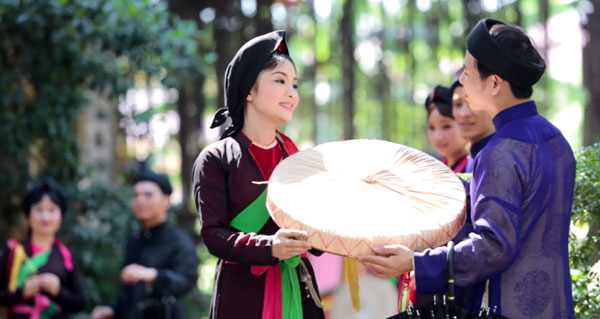I’ll provide you with detailed information about Quan họ folk singing in Bac Ninh, including customs, rituals, and notable Quan họ villages. This cultural form holds profound meaning and plays a significant role in the spiritual life of the Kinh Bac people.
1. Origin and Significance of Quan họ Folk Singing
Quan họ folk singing dates back to ancient times, originating from the old regions of Kinh Bac, including Bac Ninh and Bac Giang. Quan họ is more than a form of call-and-response singing; it’s a medium of cultural exchange, expressing emotions and fostering connections between people. Quan họ is typically performed during festivals, especially in spring when villages celebrate.
Quan họ carries cultural values, teaching lessons about friendship, romantic love, filial piety, and the traditional values of family and community.
2. Quan họ Singing Style
Quan họ has a unique singing style that requires skill and finesse:
Call-and-response singing: Quan họ involves a back-and-forth exchange between liền anh (male singers) and liền chị (female singers), who respond to each other in various melodies, symbolizing respect and harmony.
Melody and vocal techniques: Quan họ melodies are smooth and lyrical, expressing sentimentality and tenderness. Techniques such as emphasis, vibrato, and melodic gliding are employed to create a unique sound, highlighting the emotions the liền anh and liền chị wish to convey.
Distinctive pronunciation: Quan họ singers emphasize clarity, with a smooth, sweet, gentle, and resonant tone, adhering closely to regional accents.
3. Customs and Rituals in Quan họ Singing
In Quan họ, customs and rituals play an essential role in preserving tradition:
Hát canh (Night singing sessions): This is a traditional Quan họ gathering, usually held at a liền anh or liền chị’s home. During these sessions, participants wear traditional attire, such as the four-part dress (áo tứ thân), traditional tunics, and head scarves, creating a nostalgic folk atmosphere. They sing call-and-response songs, enjoy tea and betel leaves, and share stories.
Tục kết chạ (Village bonding): Villages practicing Quan họ often form bonds with other villages. When two villages are bonded, liền anh and liền chị from each village sing to one another but do not enter romantic relationships. This unique cultural tradition emphasizes friendship and neighborly harmony.
Lim Festival: Held on the 12th and 13th days of the first lunar month in Tien Du District, Bac Ninh, this is the largest Quan họ festival, drawing thousands of visitors. The festival includes Quan họ performances on boats, spontaneous singing, and other displays of this cultural art form.
4. Notable Quan họ Villages
Bac Ninh is home to more than 300 Quan họ villages, with some particularly well-known ones:
Diem Village (Viêm Xá, Hoa Long Commune, Bac Ninh City): Known as the “cradle” of Quan họ, it houses the temple of the Đức Vua Bà, whom locals believe founded the Quan họ melodies. Diem Village is known for its traditional Quan họ songs and unique singing style.
Tho Ha Village (Van Ha Commune, Viet Yen District, Bac Giang): This village has preserved Quan họ for centuries, standing out with its rustic charm and other cultural relics, like temples and pagodas. Tho Ha’s style of singing and performance attire have distinct characteristics.
Lim Village (Tien Du, Bac Ninh): Lim is famous for its annual festival and talented Quan họ groups, who preserve ancient songs and performance styles.
Biu Village (Que Vo, Bac Ninh): Also a famous Quan họ village, where liền anh and liền chị keep ancient songs and customary rituals alive.
5. Costumes and Props
Quan họ singers’ costumes are elaborate and distinctive:
Liền chị (Female singer) costumes: Typically wear layered garments (mớ ba, mớ bảy), traditional flat palm hats (nón quai thao), four-part dresses with elegant colors, and often have silk scarves around their necks. They may also carry traditional hand fans, exuding a gentle and graceful charm.
Liền anh (Male singer) costumes: Wear traditional tunics (áo the) and head scarves, conveying dignity and respect. Some liền anh may also wear a traditional scarf to complement their attire.

